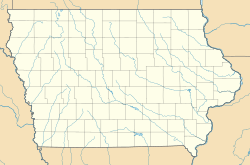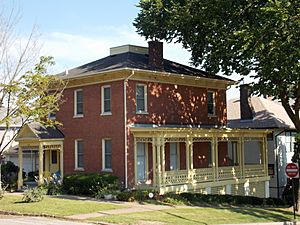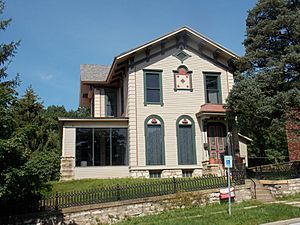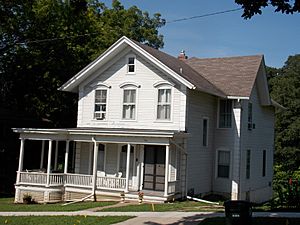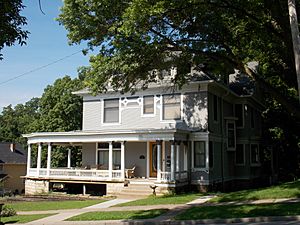Bridge Avenue Historic District facts for kids
Quick facts for kids |
|
|
Bridge Avenue Historic District
|
|
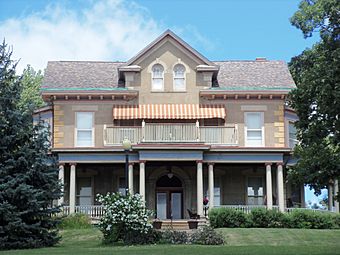
Ambrose Fulton House (1871)
|
|
| Location | Bridge Ave. from River Dr. to Ninth St., Davenport, Iowa |
|---|---|
| Area | 6 acres (2.4 ha) |
| Built | 1870-1910 |
| Architect | Multiple |
| Architectural style | Italianate Colonial Revival |
| MPS | Davenport MRA |
| NRHP reference No. | 83003626 |
| Added to NRHP | November 28, 1983 |
The Bridge Avenue Historic District is a special neighborhood in Davenport, Iowa. It's a residential area on the east side of the city. This district has been recognized as a historic place since 1983. It's listed on the National Register of Historic Places.
The district starts near the Mississippi River at River Drive. It then goes up a hill, called a bluff, to East Ninth Street. This area is known for its beautiful old homes.
What is the Bridge Avenue Historic District?
This historic district includes fourteen houses on the southern part of Bridge Avenue. The street goes up a steep hill from River Drive. It's located next to a deep valley, called a ravine. This ravine separates it from another historic area, the St. Katherine's Historic District.
To the north and west, you'll find the LeClaire Reserve. This area was once owned by Antoine Le Claire, who helped found Davenport. To the east, there's another neighborhood from the early 1900s, which includes the Prospect Park Historic District.
Most of the houses on Bridge Avenue were built between the 1870s and 1910. The oldest house in the district was built even earlier, in 1860. Ten of the houses are on the west side of the street. Four are on the east side, including the larger property of the Ambrose Fulton House. Almost all the houses are made of wood. There are two modern parts that don't fit the historic feel: a newer apartment building and a parking lot.
Who Lived Here? (Architecture and People)
One of the most important homes belonged to Ambrose Fulton. He was a very active person in Davenport's early days. He helped promote the new town and was involved in many businesses. These included flour mills, railroads, river trade, and selling land.
Many of the oldest houses in the district show off the Italianate style. This style often features decorative brackets under the roof and tall, narrow windows. The Fulton House is a great example of this. Another style seen here is Second Empire, which often has a special type of roof called a mansard roof.
Some houses have special decorative blocks on their corners. These are called quoins. Even though many of these houses are made of wood, their quoins are designed to look like stone. This was a popular way to make homes look grander. It seems other builders copied the style of the Fulton House.
Besides Ambrose Fulton, other important people in Davenport lived on Bridge Avenue.
- John B. Carmichael sold books, stationery, and wallpaper.
- Josiah Dow owned a grain mill.
- John Forrest was a local politician and helped develop businesses. He also built the Forrest Block downtown.
- After Josiah Dow passed away, his wife Maggie built a duplex (a house divided into two separate homes) on Bridge Avenue.
Notable Homes in the District
Here are some of the interesting houses in the Bridge Avenue Historic District:
- Herman Andresen House (1885) 732 Bridge Avenue. This two-story house has a unique bell-shaped mansard roof.
- John B. Carmichael House (1885) 820 Bridge Avenue. This house shows Italianate style with its curved window tops and decorative wood corners that look like stone.
- Josiah Dow House (1874) 908 Bridge Avenue. This is a Second Empire style house with a mansard roof.
- Maggie Dow House (1901) 815-815½ Bridge Avenue. This is a two-story double house with a high hipped roof. It's in the Georgian Revival style.
- John Forrest House (1875) 718 Bridge Avenue. This house combines Greek Revival and Italianate styles. It has a front gable and a side porch.
- A.C. Fulton House (1871) 1206 East River Drive. This house is a great example of vernacular (local, traditional) architecture. It mixes Italianate and Greek Revival styles in a unique way for Davenport.
- Cassius D. Hayward House (1902) 812 Bridge Avenue. This is a Georgian Revival style house with a hipped roof and dormer windows.
- W.J. Hayward House (1880) 802 Bridge Avenue. This Italianate house has an L-shape and a wide porch.
- Nathan Rambo House (1860) 1203 E. 9th Street. This brick house is a good example of the "Cube-Form" Italianate style. It has a fancy Eastlake-style entrance porch.


